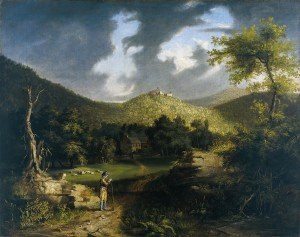 The Hudson River Valley is the birthplace of American Art. For more than 200 years artist have been inspired by its beauty—from Charles Willson Peale and Samuel F.B. Morse to Thomas Cole and the Hudson River School of landscape painting—artists painting the valley and living in the city where a century later Abstract Expressionism emerged. Before Hollywood, Fort Lee on the Palisades was a center of motion picture production, where painters like Thomas Hart Benton worked as grips and extras.
The Hudson River Valley is the birthplace of American Art. For more than 200 years artist have been inspired by its beauty—from Charles Willson Peale and Samuel F.B. Morse to Thomas Cole and the Hudson River School of landscape painting—artists painting the valley and living in the city where a century later Abstract Expressionism emerged. Before Hollywood, Fort Lee on the Palisades was a center of motion picture production, where painters like Thomas Hart Benton worked as grips and extras.
Today the Hudson Valley inspires artwork that spans a wide spectrum…from Realism to Abstraction, process-based modes, photography, digital media, hybrid media, drawings made by hand, inventions and transmutations to collages and assemblages that explore issues of environment and sustainability…all are gathered for Boscobel House & Garden’s 2011 exhibition, Hudson River Contemporary: Works on Paper and represent the continued evolution of a great American tradition.
Many of the distinguished artists in the exhibition have never shown together before. Sigmund Abeles, Fern Apfel, Carolyn Marks Blackwood, Frederick Brosen, Naomi Campbell, Linda Cross, Anne Diggory, Richard Haas, Walter Hatke, Eric Holzman, Peter Homitzky, Erik Koeppel, James Howard Kunstler, Don Nice, Sylvia Plimack Mangold, Vincent Pomilio, Raquel Rabinovich (2011 Lee Krasner Award for Lifetime Achievement winner), Susan Shatter, Joanne Pagano Weber, Ruth Wetzel and Douglas Wirls, who all respond to the Hudson watershed in various ways, while others like John Moore, Stephen Hannock, Dean Hartung and Don Stinson update the 19th century landscape painting tradition.
Abstract works by Luis Alonso, Sasha Chermayeff, Lisa Lawley allude to mapping, journals, books and domestic objects. Aurora Robson and Emily Brown use plastic waste retrieved from waterways and recycle materials from their own prior works. Photographs by Morse descendant Sarah McCoubrey document a fictional 19th century woman painter. Lensless photographs by Willie Anne Wright capture haunting images of formal gardens. Expeditionary artists Janet Morgan and Gregory Frux have kept journals and made paintings on their travels from the Shawangunks to Death Valley, Morocco and Antarctica.
Hudson River Contemporary: Works on Paper is organized by noted art historian Dr. Katherine Manthorne with her husband, visual artist and writer James Lancel McElhinney, in their first collaboration as co-curators. Catalogue essays are written by Dr. Manthorne’s doctoral students at the CUNY Graduate Center in Manhattan with an introduction by the curators and acknowledgements by noted Hudson Valley leader and benefactor Barnabas McHenry.
Hudson River Contemporary: Works on Paper opens June 15, 2011 and will run through September 15, 2011 with Gallery Talks scheduled for July 10 & 31, August 14 & 28 and September 11, 2011. The exhibition gallery is open during regular business hours and is included in the purchase of a House & Grounds pass. A full-color exhibition catalogue and poster will be available for purchase in the gift shop after June 15.
Boscobel is located on scenic Route 9D in Garrison New York just one mile south of Cold Spring and directly across the river from West Point. From April through October, hours are 9:30am to 5pm (first tour at 10am, last at 4pm). The House Museum and distinctive Gift Shop at Boscobel are open every day except Tuesdays, Thanksgiving, and Christmas. For more information, visit Boscobel.org or call 845.265.3638.
Illustration: Don Nice, Highlands Bass, 1991, 40 x 60 inches, watercolor on paper, Collection of the Hudson River Museum. Gift of the artist, 2010
 On April 2nd 1813, the Village of Sing Sing (now called Ossining) became the first incorporated municipality in Westchester County. To recall and honor that historic day, the Village of Ossining will be holding a series of commemorative activities from April through October of 2013.
On April 2nd 1813, the Village of Sing Sing (now called Ossining) became the first incorporated municipality in Westchester County. To recall and honor that historic day, the Village of Ossining will be holding a series of commemorative activities from April through October of 2013.







